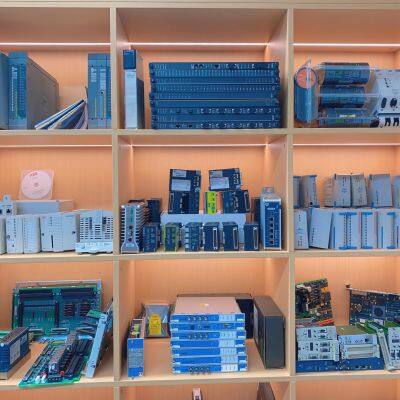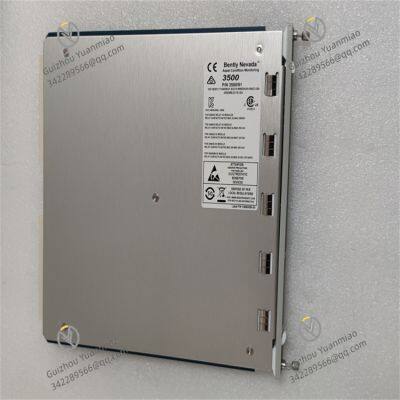Product Description
I. Product Overview
BENTLY 190782-01, as an extremely critical communication gateway module in the 3500 monitoring system, plays an indispensable role in the industrial equipment condition monitoring system. It focuses on building a comprehensive and efficient communication bridge for various values and equipment status monitored by the 3500 rack, enabling smooth interaction of equipment operation data between different systems, and effectively promoting automated control and equipment status management in the industrial production process.
The module has a compact design with dimensions of 263×58×28mm and a weight of approximately 4.3kg. Such specifications allow it to easily fit into the rack of the 3500 monitoring system, enabling convenient installation in limited spaces. Its shell is made of strong and durable materials, which not only has good impact resistance but also provides reliable protection for the internal precision electronic components. It can effectively resist common adverse factors in industrial environments such as dust, oil pollution, and electromagnetic interference, ensuring that the module can operate stably for a long time under complex and harsh working conditions.

II. Performance Characteristics
(1) Strong Support for Communication Protocols
EGD protocol compatibility: 3500/91M is highly compatible with the EGD (Ethernet Global Data) protocol and supports version 2.01. With this protocol, it can seamlessly interface and work collaboratively with many controllers that comply with EGD standards (such as GE Mark*VIE controllers). In industrial production scenarios, there are many devices of different brands and models. Through the EGD protocol, 3500/91M can accurately transmit the equipment operation data collected by the 3500 monitoring system to the corresponding controllers, allowing the controllers to regulate the equipment in real-time and accurately based on these data, ensuring the stable and efficient progress of the production process.
Ethernet UDP/IP communication: This module fully supports the Ethernet UDP/IP communication protocol, which is widely used in the field of industrial Ethernet communication and has the advantages of fast transmission speed and high efficiency. Through UDP/IP communication, 3500/91M can quickly respond to various data requests and transmit key monitoring data such as equipment vibration, displacement, and rotational speed to other systems at an extremely fast speed, providing timely and accurate data support for industrial automation control, significantly improving the system's response speed to changes in equipment status, and effectively reducing the risk of control lag caused by data transmission delays.
Other protocol expansions: In addition to the above core protocols, 3500/91M also supports various common industrial communication protocols such as Modicon Modbus protocol (implemented through serial communication), Modbus/TCP protocol (a serial Modbus variant for TCP/IP Ethernet communication), and Bently Nevada proprietary protocol (used for communication with 3500 rack configuration and data acquisition packages). This rich protocol support capability greatly enhances the versatility and compatibility of the module, enabling it to flexibly adapt to the communication needs of different industrial automation systems, easily integrate into complex and diverse industrial network architectures, and realize the sharing and interaction of equipment data in a wider range.

(2) Reliable Operational Stability
Hardware reliability design: The module uses high-quality electronic components internally and undergoes rigorous circuit design and optimized layout. It can still maintain stable operation in the face of common problems in industrial environments such as voltage fluctuations and electromagnetic interference, ensuring the accuracy and continuity of data transmission. Its internal circuit has good anti-interference ability, which can effectively shield the impact of external electromagnetic signals on data transmission, prevent data loss or errors, and provide a strong guarantee for the stable operation of the equipment condition monitoring system.
Strong environmental adaptability: 3500/91M can adapt to a wide temperature range in industrial environments, usually from -22°F to 150°F (i.e., -30°C to 65°C), and a certain range of humidity. It can work normally in high-temperature and high-pressure chemical production workshops as well as cold and humid outdoor industrial facilities, showing excellent environmental adaptability. This excellent environmental adaptability enables the module to be widely used in various complex industrial scenarios, providing reliable communication support for equipment condition monitoring in different industries.
Self-diagnosis and fault early warning function: The module has a built-in advanced self-diagnosis system, which can monitor the operation status of its own hardware and software in real-time. Once an abnormal situation is detected, such as hardware failure or communication interruption, it will immediately send out a fault alarm signal and generate a detailed fault log, recording the time, type, and related parameter information of the fault. This function helps maintenance personnel quickly locate and troubleshoot faults, take corresponding measures for repair in a timely manner, significantly shorten equipment downtime, reduce economic losses caused by equipment failures to enterprises, and improve the continuity and reliability of industrial production.

III. Installation and Configuration
(1) Installation Steps
Preparation before installation: Before starting to install BENTLY 3500/91M, a comprehensive and detailed inspection of the module is required. Carefully check the appearance of the module to ensure there is no damage, deformation, or missing parts. At the same time, strictly compare with the product manual and packing list, check the model and specification of the module one by one to ensure they are accurate, and confirm that related accessories (such as mounting screws, connecting cables, etc.) are complete and match the product. The installation environment should also be strictly inspected to ensure that the installation location is dry, well-ventilated, away from strong electromagnetic interference sources, high-temperature heat sources, and corrosive substances, and that the ambient temperature and humidity meet the operating requirements of the module. In addition, necessary installation tools such as screwdrivers, wrenches, and wire crimpers need to be prepared, and ensure that the tools are accurate and intact.
System configuration: After the hardware installation is completed, parameter configuration of BENTLY 3500/91M needs to be carried out through the configuration software of the 3500 system. During the configuration process, various parameters should be set reasonably according to factors such as the type of actually monitored equipment, communication requirements, and system architecture, such as communication protocol selection, data transmission rate, alarm thresholds of monitoring parameters, sampling frequency, signal type, etc. Through personalized configuration, ensure that the module can work accurately and efficiently with the entire 3500 monitoring system, and collect and transmit equipment operation data accurately. After configuration, conduct a power-on test on the module to comprehensively check whether the module can work normally and whether all functions are realized normally, such as whether the communication function is smooth, whether data transmission is accurate, and whether the alarm function is sensitive. If problems are found during the test, they need to be Investigation and solved in a timely manner until the module operates completely normally.
(2) Configuration Key Points
Software version requirements: To ensure the compatibility and stability of 3500/91M with the 3500 monitoring system, it is necessary to use version 3.70 or higher of the 3500 rack configuration software. Lower versions of the software may not fully support all functions of 3500/91M or may have compatibility issues during operation, affecting the normal operation of the module. Therefore, before performing system configuration, be sure to confirm that the software version used meets the requirements.
Communication parameter settings: When configuring communication parameters, it is necessary to reasonably set network parameters such as IP address, subnet mask, and gateway according to the actual network environment and communication requirements to ensure that the module can establish a stable and reliable communication connection with other devices. At the same time, according to the communication protocol used (such as EGD, UDP/IP, etc.), correctly set protocol-related parameters such as port number and data transmission format. Incorrect communication parameter settings may cause the module to fail to communicate normally, affecting the transmission of equipment operation data and the overall performance of the system. Therefore, when setting communication parameters, careful operation and sufficient testing and verification are required.


ABB GFD563A102 3BHE046836R0102 Excitation Convection Interface Module
ABB PPD117A3011 3BHE030410R3011 Excitation Controller
ABB PCD231B101 3BHE025541R0101 Excitation Unit Controller
ABB 5SHY3545L0010 3BHE009681R0101 High-Voltage Thyristor Module
ABB PCD230A 3BHE022291R0101 Controller Module
ABB 5SHY3545L0009 3BHB013085R0001 IGBT Module
Bently Nevada 3500/25 enhanced key phase module
Bently Nevada 3500/32 4-channel relay module
ABB PCD232A 3BHE022293R0101 Exciter Control Module
Bently Nevada 3500 monitoring system series modules
Bently Nevada 3500/33 relay module
ABB PCD235A101 3BHE032025R0101 Excitation Control Module
ABB PCD235C101 3BHE057901R0101 Excitation Unit Controller
Bently Nevada 3500/34 Triple redundant relay module
ABB PCD530A102 3BHE041343R0102 Controller
ABB PPD113B01-10-150000 3BHR023784R1023 Controller Module
ABB PPD512A10-150000 3BHE040375R1023 Excitation Controller
Bently Nevada 3500/40 monitor module
 yezi
Hi there! Welcome to my shop. Let me know if you have any questions.
yezi
Hi there! Welcome to my shop. Let me know if you have any questions.





